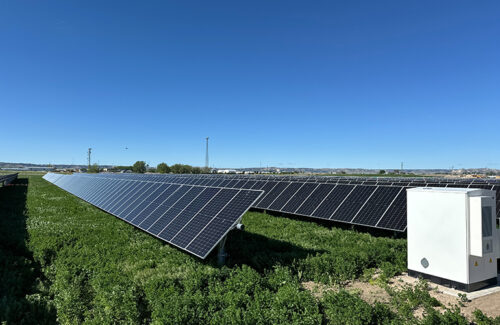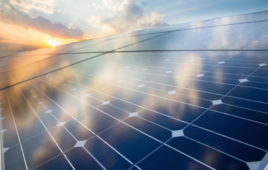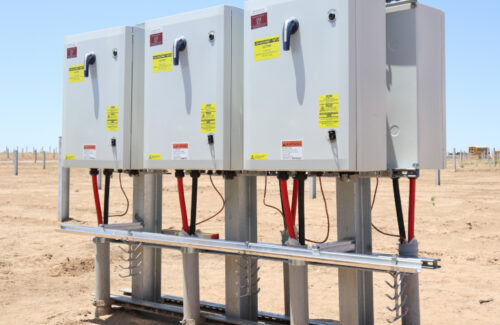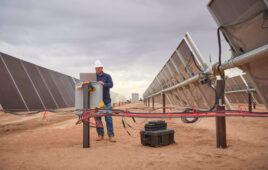

GenPro Energy Development has completed the construction of a microgrid powered by solar energy and energy storage for CS Precision Manufacturing in Green, Nebraska. This solar microgrid is the first of its kind in the state, powered by 1560 550 watt solar modules and three BYD Chess 120 kilowatt energy storage units. A few years ago, CS Precision Manufacturing began to see solar energy as a viable option to subsidize energy consumption, "said CEO Scott James. We quickly realized that the many benefits of solar energy go far beyond financial aspects. Environmental benefits, partial energy independence, stable energy costs, and community responsibility were the key factors driving our decision to implement a solar farm. Solar energy is a clean and renewable energy source that does not emit any greenhouse gases. By reducing our dependence on traditional energy sources, we will minimize our carbon footprint and help address climate change to the greatest extent possible Before converting the facility to solar energy, CS Precision hired GenPro Energy to conduct a feasibility study. When we launched the project in 2020, the interval data provided by the utilities was very limited, "said Molly Brown, who led the development of GenPro. We have installed data loggers at every utility service and collected 1-minute interval data for a whole year After collecting and uploading interval data for analysis, other technical issues need to be addressed. This facility has four different types of power services. GenPro has partnered with Gering's power company and its wholesale supplier, the Nebraska Municipal Energy Authority, to reconfigure the interconnection between the facility and the distribution network. The design of microgrids can store energy and use it when demand increases, thereby offsetting peak usage times. Compared to fossil fuels, solar energy provides a more stable cost structure.

Sandhills Energy plans to commence construction of two solar projects in Indian Nora and Waverley, Iowa, each exceeding 4 megawatts. These projects are part of Sandhills Energy's ongoing collaboration with the Nebraska Municipal Energy Authority (MEAN) to strengthen renewable energy generation and promote energy independence in 16 communities across 15 locations in the Midwest. The on-site construction of these two projects is expected to begin in the first quarter of 2025, awaiting final environmental approval from the US Department of Agriculture. Indian Nora and Waverly are one of four MEAN member communities located in Iowa, ready to develop solar energy. Through this partnership, Indienora Municipal Utilities (IMU) and Waverley Utilities (WU) can obtain wholesale electricity supply from MEAN and combine solar power with traditional energy sources to improve the resilience of the local power grid and reduce costs during peak electricity periods. Denver and Seget Bluff communities will install similar solar facilities by 2025. As Western Union strives to diversify its power structure, solar energy is an important component, "said Curt Atkins, General Manager of Western Union. As our hydroelectric power units retire in 2022, new solar cell arrays will replace the electricity produced by hydroelectric power units The 4.2-magnitude power plant located in Nora, India, covers an area of 25 acres and is owned by IMU. It is expected that the summer peak load will decrease by 10% and the winter peak load will decrease by 40%. The solar power plant located in Waverley covers an area of approximately 24 acres and can provide up to 6.5 million kilowatt hours of electricity annually. Indian Nora Municipal Utilities Company will not only provide reliable electricity in the coming years; we will also create a cleaner and greener future for our community, our children, and their children, "said IMU General Manager Chris Desplanques. Sandhills Energy and MEAN held groundbreaking ceremonies in June in Alianes and Sidney, Nebraska, launching the construction of 15 solar facility series. The solar facilities in these member communities will account for 5% of the energy usage in 16 cities. Raki Giannakouros, Executive Vice President of Sandhills Energy, said, "The First Solar Series 6 photovoltaic panels in these solar facilities are very suitable for the situation in the Midwest region, with anti hail, anti snow chassis structures and the industry's best anti-aging warranty. In the turbulent utility market, solar projects will provide stability and first day savings, which are expected to increase over time as wholesale energy prices rise

Every year on the 15th day of the eighth lunar month, every household celebrates this festival to pray for family reunion and a bountiful harvest. Here are some traditional customs of Mid-Autumn Festival: Eating mooncakes Moon cakes are the traditional food of Mid-Autumn Festival, symbolizing reunion and integrity. Traditional mooncakes come in various flavors, such as bean paste, lotus seed paste, and five nuts. Modern mooncakes are more diverse, including ice skin mooncakes, chocolate mooncakes, and so on. Sharing mooncakes is not only to satisfy taste buds, but also a way to convey blessings and reunion. Appreciating the Moon On the night of Mid Autumn Festival, the moon is at its fullest and brightest, and people often gather together to appreciate the bright moon and express their thoughts and blessings to their loved ones. Appreciating the moon is an ancient custom, symbolizing the longing and pursuit of a better life. Carrying lanterns Especially among children, carrying lanterns is an interesting custom of Mid-Autumn Festival. Lanterns of various shapes light up the night sky, adding color and joy to the festival. Traditional lanterns are made of paper, while modern lanterns are more diverse and can even be glowing plastic lanterns. Family reunion Mid-Autumn Festival is a time for family reunion. No matter where people are, they should try to return home and spend this warm holiday with their loved ones. Family members usually sit together, enjoying a sumptuous dinner and discussing the little things from the past year. Offering sacrifices to the moon and praying for blessings Traditionally, people also hold a ceremony of offering sacrifices to the moon on Mid-Autumn Festival to pray for harvest and peace. This custom originated from the ancient worship of the moon, reflecting people's reverence for nature and their expectations for a better future. The traditional customs of the Mid-Autumn Festival not only display China's rich cultural heritage, but also reflect people's yearning for family, reunion and a better life. No matter how the times change, these traditions are constantly inherited and carried forward, so that every Mid-Autumn Festival is full of strong cultural atmosphere and warm feelings.

Affordable Wire Management (AWM) officially released its Pinyon Hanger at RE+2024. Pinyon cable management solutions are tailored specifically for north-south mainline bus systems. Pinyon Hanger's asymmetric structure can directly support load-bearing cables on piles without the need for support brackets. This can reduce materials and labor, decrease torque loads on piles, and minimize the area required to accommodate cable management systems. Pinyon is also useful in specific site conditions and layouts, especially when multiple trackers are installed in the form of long columns from north to south. Hangers can also be used to secure tilting systems. Pinyon not only reduces costs and improves installation efficiency, but also extends these advantages to long-term operation and maintenance. Longevity makes Pinyon and our other suspension products sustainable choices for solar projects, in line with the industry's goal of creating resilient and sustainable renewable energy infrastructure, "said Scott Rand, CEO and co-founder of AWM.

Affordable Wire Management (AWM) has launched its SUMAC rails to the utility grade solar industry. The line management system optimized for cluster circuit breaker boxes eliminates the need for cable trays. SUMAC rails are compatible with AWM's Arden and Pinyon hangers. The hanger can be securely connected to the SUMAC rail using the same single crimping process as the AWM hanger. SUMAC is a sag free load-bearing cable replacement designed for short distance scenarios that require precise cable layout. Aluminum alloy tracks can help cable management systems safely navigate tracker drive lines and other critical areas. SUMAC does not require end columns, it replaces the cable trays, cable ties, and clamps required for these arrangements. It can withstand additional loads without the need to place extra piles around the disconnector cluster and drive lines. Our SUMAC track sets industry-leading standards in safety, reliability, and availability, "said Scott Rand, CEO and co-founder of AWM. In addition, replacing cable trays with SUMAC means less material consumption, lowest labor costs, and the advantage of zero sag. SUMAC achieves unified cable layout throughout the entire site, which also means uniformity in current carrying capacity. The steel and O&M costs of public utility scale projects have significantly decreased This product does not contain polymer materials and has a service life of over 40 years. It can withstand all weather conditions: temperatures ranging from -40 ° C to+150 ° C, extreme ice and snow loads, and corrosive environments.

Fluke has launched two new products today - the Fluke 283 FC solar digital multimeter and the Fluke a283 FC true RMS wireless clamp meter, which enable solar professionals to work more confidently without compromising safety in high voltage environments, such as testing individual panels, strings, or inverters in utility scale solar photovoltaic arrays. Fluke's new 283 FC digital multimeter aims to improve safety and productivity while providing accurate, reliable, and reproducible results for technicians. The Fluke 283 FC/PV solar kit includes CAT III 1500 V DC safety grade accessories, allowing technicians to work confidently in high voltage environments. With the Staubli MC4 test leads, professionals can quickly, reliably, and safely connect to modules or strings to test DC voltages up to 1500 V, making it ideal for utility operations. The TL175-HV CAT III 1500 V/CAT IV 1000 V rated silicone test leads can flexibly test the voltage, millivolts, resistance, continuity, and capacitance on inverters, combiner boxes, photovoltaic arrays, and individual photovoltaic modules. Jason Waxman, President of Fluke, stated, "Our digital multimeter is renowned for its exceptional accuracy, durability, and safety, making it the preferred choice for professionals in various industries for reliable and precise measurements. The Fluke 283 FC has a unique advantage in meeting the needs of this market, with both CAT III 1500 and CAT IV 1000 ratings, prioritizing features that improve efficiency, safety, and reliability. For solar professionals, this is a powerful integrated tool The a283 FC True RMS wireless current clamp simplifies the troubleshooting process without compromising safety and reliability. It can measure AC and DC currents up to 60 A, ensuring accurate readings for solar installations, electrical systems, and industrial equipment. Its thin jaws are designed specifically for narrow spaces such as combiner boxes or inverters. Non contact design prioritizes safety and enables safe connections without the need to touch live wires. In addition, wireless connections eliminate the hassle of wire entanglement and can be measured from a safe distance. With the help of Fluke 283 FC digital multimeter and a283 FC wireless clamp, technicians can simultaneously measure voltage and current and automatically calculate VA power. This feature does not require changing measurement settings and can seamlessly and efficiently collect data on site. By utilizing Fluke Connect and Fluke cloud storage capabilities, 283 FC users can enjoy an enhanced troubleshooting experience, as 283 FC can transmit measurement results to smartphones or tablets for detailed analysis, and then upload them to the cloud.

According to the "US Solar Market Insights Q3 2024 Report" released today by the Solar Energy Industry Association of America (SEIA) and Wood Mackenzie, as the solar industry installed 9.4 gigawatts of new generation capacity in Q2 2024, federal clean energy policies continue to drive manufacturing and deployment growth. Within two years of the implementation of the IRA, the solar industry added 75 gigawatts of installed capacity to the grid, accounting for over 36% of the historical solar power generation capacity in the United States. Since the IRA was passed, nearly 1.5 million American households have installed solar energy. SEIA President and CEO Abigail Ross Hopper said, "The solar and energy storage industry is putting federal clean energy policies into action, rapidly creating job opportunities, and driving economic growth in all 50 states in the United States, especially Arizona, Nevada, and Georgia. We are currently producing a historic high of solar energy in the United States, and soon we will have enough domestic module production to meet almost all of America's demand in the coming years Texas continues to dominate the solar energy market, with 5.5 gigawatts of solar capacity installed in the first half of 2024, leading the United States. Texas, Florida, Nevada, Ohio, and Arizona, which were highly anticipated in the November elections this year, are all among the top ten states in terms of solar capacity in 2024. The solar industry performed exceptionally well in the second quarter, mainly due to the growth in the utility scale sector, "said Michelle Davis, Global Head of Solar Energy at Wood Mackenzie and lead author of the report. However, the future growth of solar energy is hindered by broader challenges in the power industry, such as backlogs in interconnectivity, shortages of electrical equipment, and limited labor supply. The industry also faces uncertainty related to newly proposed tariffs and presidential elections. Currently, there are many issues in the solar energy industry that need to be addressed Affected by policy changes in California and high national interest rates, the residential solar market continued to shrink in the second quarter of 2024. The industry added 1.1 gigawatts of production capacity in the second quarter, the lowest in nearly three years. However, the residential solar energy market is expected to grow again in 2025 and is expected to set an annual record in 2026-2029. As the solar energy industry addresses the aforementioned challenges, the annual installed capacity of solar energy is expected to increase by an average of 4% in the coming years. By 2029, the total installed solar capacity in the United States is expected to double to 440 gigawatts. According to the "US Solar Market Insights Q3 2024 Report" released today by the Solar Energy Industry Association of America (SEIA) and Wood Mackenzie, as the solar industry installed 9.4 gigawatts of new generation capacity in Q2 2024, federal clean...

National Grid Renewables has announced the start of on-site construction for its Dodson Creek solar project located in Highland County, Ohio. Once put into operation, the Dodson Creek project located in the PJM market will provide 117 megawatts of clean solar energy and bring approximately $49 million in direct economic benefits to the local community. The project is expected to commence operations in mid-2025. Dodson Creek is the fourth project we have started in Ohio and the second project we have started in Highland County, "said Joe Ibrahim, Vice President of Construction and Engineering at State Grid. This project is the next chapter in our commitment to helping communities across Ohio achieve the economic benefits of clean energy transition Dodson Creek follows closely behind the Yellowbud Solar project operated by National Grid Renewables, which is the first and largest project in its Ohio investment portfolio, as well as its ongoing projects Ross County Solar and Fayette Solar. Overall, in addition to a strong development portfolio, these four projects also represent the entire Buckeye state's 558.5 MW construction and operation project portfolio. Dodson Creek will have a positive impact on the local community in many ways. Throughout the entire construction phase, this 1300 acre project will create and maintain approximately 200 construction jobs. Dodson Creek has signed a contract with Kiewit to become its engineering, procurement, and construction (EPC) partner. Brian Koller, Vice President of Kiewit Power Constructors Co., said, "Our fourth collaboration with NG Renewables on the Dodson Creek solar project demonstrates our enduring partnership and commitment to renewable energy. We value the strong relationships we have established with local unions and Highland County communities. Kiewit is proud to contribute to a sustainable future through the Dodson Creek solar project In order to continue the long-term partnership with First Solar, the Dodson Creek project will adopt the next-generation 7-series modules developed and produced by First Solar at its Toledo manufacturing plant in Ohio.

Nevados is a solar tracker developer whose products can adapt to uneven terrain and are currently accepting orders for their new TRACE solar tracking solution. TRACE is Nevados' new generation all terrain tracker designed for steep and undulating terrain with slopes up to 37%, which can protect the native surface soil. Through TRACE, Nevados has updated the mechanical operation of the system, integrated software and controls, including features such as 75 ° hail storage, further reducing the risk of wind, snow, and hail to the project. It has terrain aware backtracking function, which can reduce shading and thus increase energy production. Yezin Taha, CEO and founder of Nevados, said, "Through TRACE, we have turned the all terrain tracker (already the most powerful and easy to install product on the market) into a more cohesive and fully functional product Project risk mitigation measures Bidirectional automatic retraction, accelerating windproof and hail resistant retraction. 75 ° Hail Stow can reduce the probability of maximum damage (PML) caused by hail. Flood, rainwater, and system protection storage protocol. TRACE adopts a backtracking rotation plan that considers specific terrain profiles to reduce the impact of background. This feature is a standard configuration for every tracker. These rotation plans can be distributed between rows to increase production, and the system can consider diffuse light. TRACE uses Kinematics ST Drive, which does not require lubrication and therefore requires minimal maintenance The total number of parts in the system has been reduced by 35% and comes with pre installed materials. The system can be installed using Milwaukee Tool's controlled torque impact wrench. Nevados also provides an O&M dashboard for system management, which includes access to system history. As flat or gentle slopes become increasingly scarce and expensive, the solar energy industry needs solutions more than ever that can adapt to the world's diverse terrains, "Taha said. We constantly innovate and redefine the possibilities of solar energy development. We are able to achieve rapid and efficient deployment on sites that were previously considered too complex or costly Nevados is currently accepting orders for the TRACE all terrain tracking system, which is expected to be delivered in the second quarter of 2025. This system can be ordered as a fully qualified domestic content tracker for the US market, helping solar developers meet additional tax credit requirements under the Inflation Reduction Act. The TRACE system will be exhibited at Nevados RE+booth D24705 in Hall D of the Anaheim Convention Center from September 9th to 12th. News from Nevada
Categories
New Products
Tin Roof Rapid Solar Mounting System with Hanger Bolt Read More
Residential Small Solar Easy Bracket Kit for Home Balcony Read More
Automatic Single Pile Solar Tracker with 10 PV Panels Read More
Angle Adjustable Aluminum Easy Solar Panel Bracket for Garden Read More
Intelligent Single Post Dual Row Solar Tracking System Read More
5000ES Solar Off-Grid Energy Storage Inverter Supplier Read More
Multi Drive Double-Sided Single Axis Tracker System Read More
© Copyright: 2025 Xiamen Wintop New Energy Tech Co., Ltd.. All Rights Reserved.

IPv6 network supported